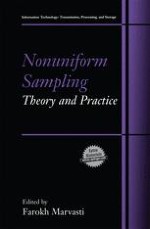2001 | OriginalPaper | Buchkapitel
Sparse Sampling in Array Processing
verfasst von : S. Holm, A. Austeng, K. Iranpour, J.-F. Hopperstad
Erschienen in: Nonuniform Sampling
Verlag: Springer US
Enthalten in: Professional Book Archive
Aktivieren Sie unsere intelligente Suche, um passende Fachinhalte oder Patente zu finden.
Wählen Sie Textabschnitte aus um mit Künstlicher Intelligenz passenden Patente zu finden. powered by
Markieren Sie Textabschnitte, um KI-gestützt weitere passende Inhalte zu finden. powered by
Sparsely sampled irregular arrays and random arrays have been used or proposed in several fields such as radar, sonar, ultrasound imaging, and seismics. We start with an introduction to array processing and then consider the combinatorial problem of finding the best layout of elements in sparse 1-D and 2-D arrays. The optimization criteria are then reviewed: creation of beampatterns with low mainlobe width and low sidelobes, or as uniform as possible coarray. The latter case is shown here to be nearly equivalent to finding a beampattern with minimal peak sidelobes.We have applied several optimization methods to the layout problem, including linear programming, genetic algorithms and simulated annealing. The examples given here are both for 1-D and 2-D arrays. The largest problem considered is the selection of K = 500 elements in an aperture of 50 by 50 elements. Based on these examples we propose that an estimate of the achievable peak level in an algorithmically optimized array is inversely proportional to K and is close to the estimate of the average level in a random array.Active array systems use both a transmitter and receiver aperture and they need not necessarily be the same. This gives additional freedom in design of the thinning patterns, and favorable solutions can be found by using periodic patterns with different periodicity for the two apertures, or a periodic pattern in combination with an algorithmically optimized pattern with the condition that there be no overlap between transmitter and receiver elements. With the methods given here one has the freedom to choose a design method for a sparse array system using either the same elements for the receiver and the transmitter, no overlap between the receiver and transmitter or partial overlap as in periodic arrays.
